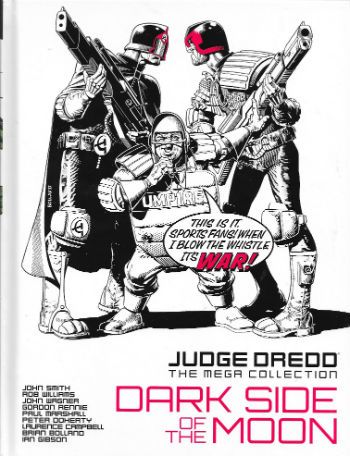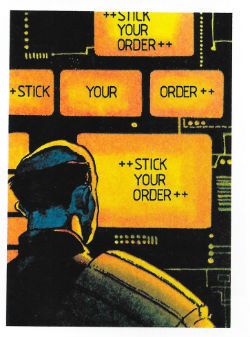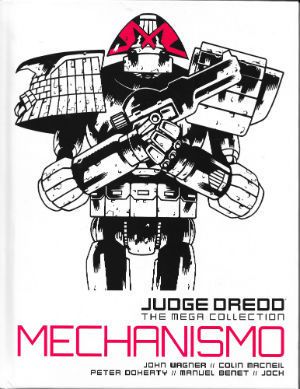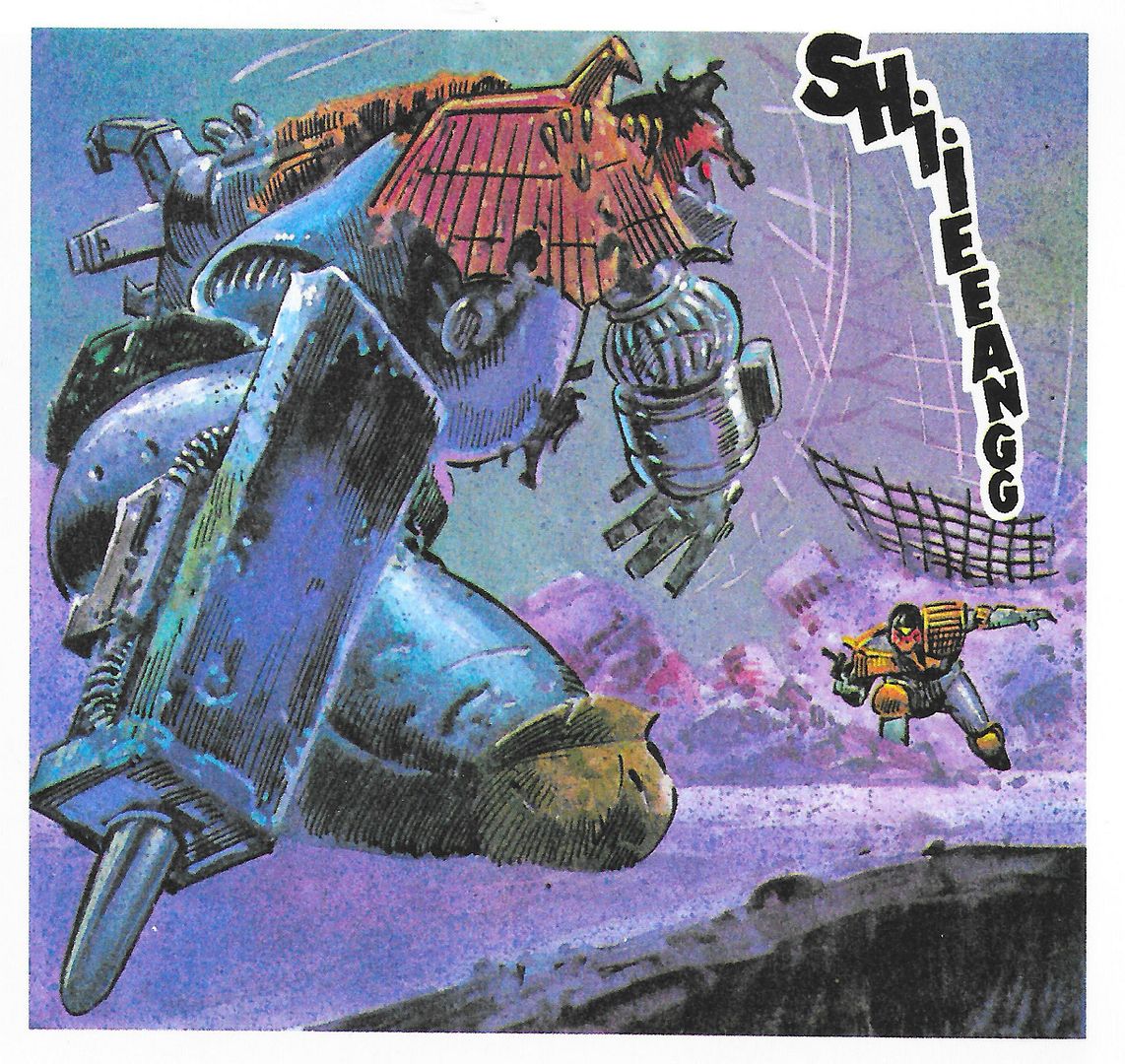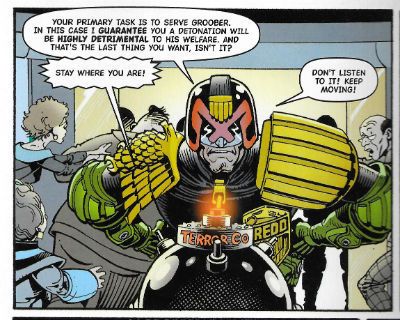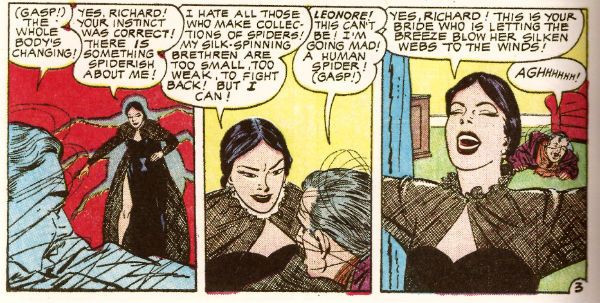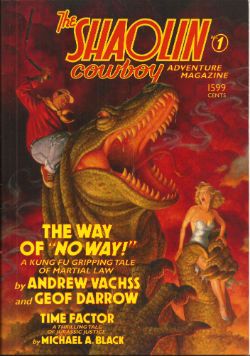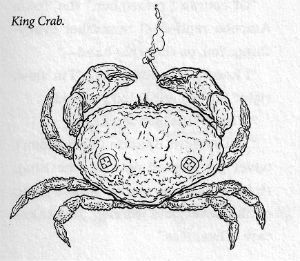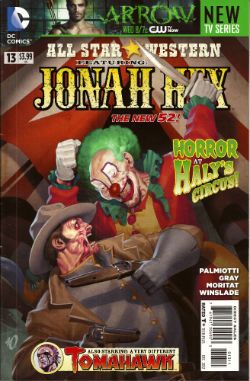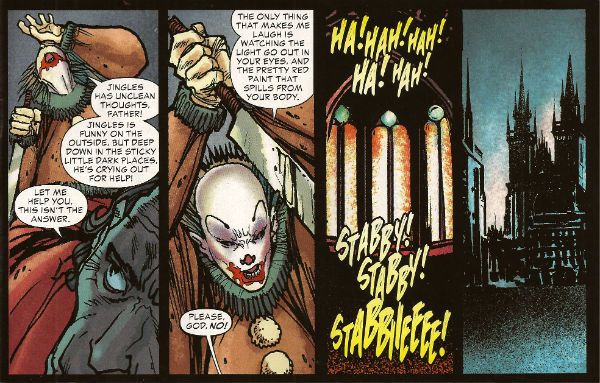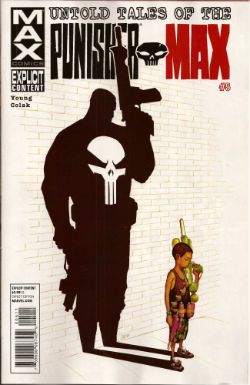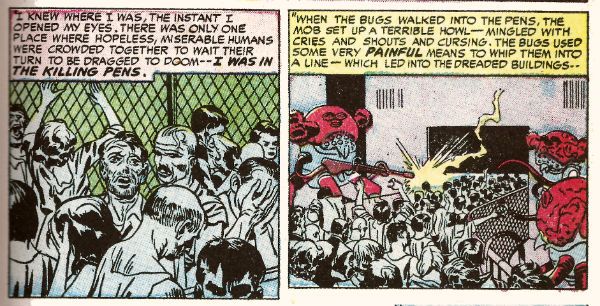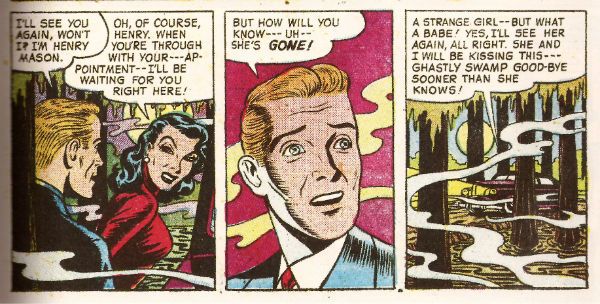"...Do Not Adjust Your Brains!" COMICS! Sometimes "M-O-O-N" Spells “Moon”, Despite What Tom Cullen Thinks.
/Judge Dredd on the moon. That's it.
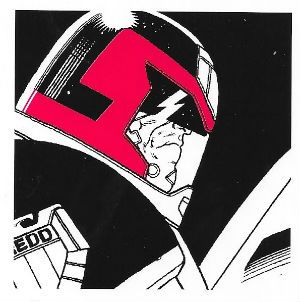 JUDGE DREDD: DARKSIDE by Marshall
JUDGE DREDD: DARKSIDE by Marshall
Anyway, this…
THE JUDGE DREDD MEGA COLLECTION REVIEW INDEX
JUDGE DREDD: THE MEGA COLLECTION Vol. 80: DARK SIDE OF THE MOON Art by Paul Marshall, Peter Doherty, Laurence Campbell, Lee Townsend, Brian Bolland, Mick McMahon and Ian Gibson Written by John Smith, Rob Williams, John Wagner and Gordon Rennie Lettered by Tom Frame, Ellie De Ville, Tony Jacob and Simon Bowland Colours by Alan Craddock, Peter Doherty and John-Paul Bove Originally serialised in 2000AD Progs 47, 50-52, 57, 1017-1028 & 1468, JUDGE DREDD MEGAZINE 328-331 © 1978, 1996,2005, 2012 & 2016 Rebellion A/S Hatchette Partworks/Rebellion, £9.99 (2016) JUDGE DREDD created by Carlos Ezquerra & John Wagner
JUDGE DREDD: DARKSIDE Art by Paul Marshall Written by John Smith Coloured by Alan Craddock Lettered by Tom Frame Originally published in 2000AD Progs 1017-1028
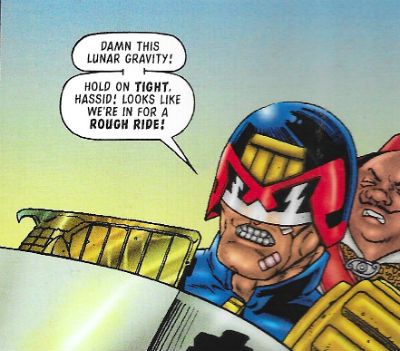 JUDGE DREDD: DARKSIDE by Marshall, Smith, Craddock and Frame
JUDGE DREDD: DARKSIDE by Marshall, Smith, Craddock and Frame
The order of these stories are all to cock chronology wise. The earliest Luna-1 stories are later in the book. I'm not sure why that is but we start with another disappointing John Smith Dredd outing. All the more disappointing because there are some pretty nifty elements here, but it all fails to gel. Someone is murdering people on the Luna-1 colony, someone with Judge Dredd's DNA! Worse, old Stony Face is actually on the moon pursuing a perp while also accompanying Psi Judge Hassad who has had “premonitions of a premonition”, so it could actually be Dredd. In fact who else could it be? It's a really promising set-up, but Smith fails to capitalise on it and plays his hand far too soon. What you end up with instead of a murder-mystery is a lot of running about bumping into call-backs to older, better stories.
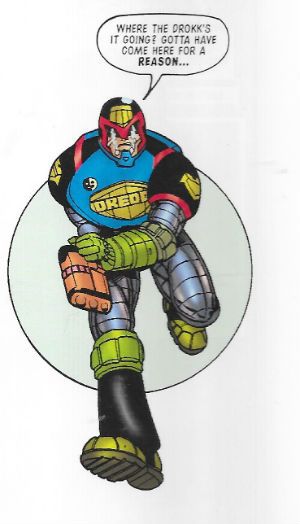 JUDGE DREDD: DARK SIDE by Marshall, Smith, Craddock and Frame
JUDGE DREDD: DARK SIDE by Marshall, Smith, Craddock and Frame
He's aided and abetted by Marshall's clean line and chunky directness, which in turn is lent pizzazz by Craddock's vivid colours, which include photographic elements. The colours give it an otherworldly touch and the art successfully casts everything in a serio-comic mode. But it's all for naught as the tale is torpedoed by Smith's failure to balance his disparate elements. Usually his blend of comedy and horror is jarring, but intentionally so. Here his hands are too heavy on the horror and the humour both; resulting in a tonal roller-coaster of brutal murders which keeps ploughing into the candyfloss stand of the overly broad comedy, because for some reason it's on the track instead of down below next to the boating pond. Some of this sense of humour failure stems from Smith's distaste for the Judicial System; having Dredd interrogated by a Teutonic sadist complete with monocle and duelling scars is slapstick rather than satire. Some of the sense of humour failure is...well, inexplicable really; Psi Judge Hassad's a step too close to the old “Dearie Dearie me!” stereotype for comfort, never mind comedy. (Later we'll see some more unfortunate stereotypes; being white, male and totes privileged I'm willing to give stuff from the '70s a grudging pass, but not from the '90s.) I get the impression John Smith doesn't enjoy writing Dredd much, which is fine, each to their own but unfortunately more often than not it ends up with the reader not enjoying reading Judge Dredd. That’s less than ideal. EH!
BREATHING SPACE Art by Peter Doherty,Laurence Campbell and Lee Townsend Written by Rob Williams Coloured by Peter Doherty Lettered by Ellie De Ville Originally published in 2000AD Progs 1451-1459
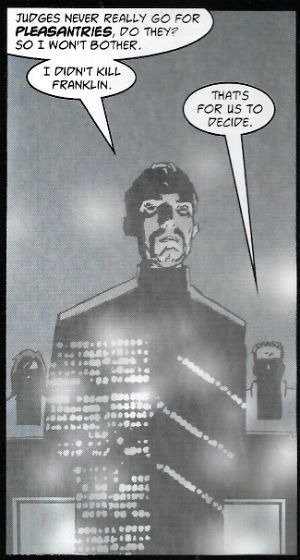 BREATHING SPACE by Doherty, Campbell, Townsend, Williams and De Ville
BREATHING SPACE by Doherty, Campbell, Townsend, Williams and De Ville
Regular Squaxx dex Kano will know that in the comments we've been having a bit of a think about who “gets” Judge Dredd; it being a bit of a notable failure on the part of some Dredd scribes. Turns out it's a matter of opinion! Anyway, here we have a good way of avoiding that problem; Judge Dredd isn't in Breathing Space. It's a space-noir which uses the enclosed environment of Luna 1 to excellent advantage. The newly appointed Chief Marshal of Luna 1, Judge King, steps onto the lunar surface and straight into a mess of corrupt Judges, corporate backstabbing and...MURDER! In a nice tip of the space-fedora to SUNSET BOULEVARD the story starts with a dead man, and then we go back and see how he ended up there. It's not so much whodunnit as a whydidhedowhathedunnit. Any greater detail risks an eruption of the Thrill Suckers' ambrosia – SPOILERS!
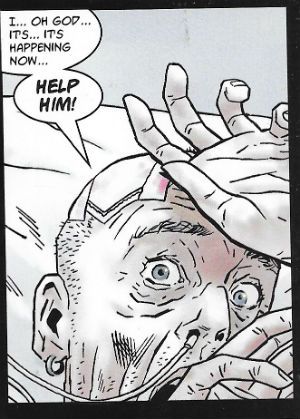 BREATHING SPACE by Doherty, Campbell, Townsend, Williams and De Ville
BREATHING SPACE by Doherty, Campbell, Townsend, Williams and De Ville
For such a sweet read it's odd to find in the text at the back that Breathing Space had a troubled gestation. Due to illness Doherty (he got better; don't send cards) draws only the initial episodes but Campbell & Townsend pick up from him so delicately that you barely sense a switch in style. Although episodes appeared regularly, apparently it was written over three years (by which I mean there was a ruddy great hiatus in there, not that Williams' was honing it over a three year period like some kind of Joycean perfectionist; as good as it is it's still space-noir not ULYSSES, people), but you'd not guess as the pared down style reads smooth as a successful getaway. The consistency is helped no end by Doherty's continued presence as colourist; his use of a strictly limited and thoroughly muted palette sets a suitably sombre tone for the dour proceedings. The whole thing zips glumly along and Williams' intelligent plot is peppered with characters just the right side of caricature, there's some nifty misdirection and the vital plot point is rooted firmly in the “Dredd” universe. Placed as it is after Smith & Marshall's misfire of dayglo clowning the success of Breathing Space's restrained doom-mongering seems all the greater. There's no Dredd in it but it's still VERY GOOD!
Thus starts a brief run of the original Luna 1 stories. It's not all of them; just those with art by Brian Bolland, because everyone likes to remember when you would get weekly doses of Bolland Thrill-Power. Fat chance of that now. I'll burn through these, because they are from that period when Dredd was finding its feet as a strip. Any elements that have survived into the Dredd canon (NOT cannon; that's a thing that fires projectiles. Make a note of that.) are sparse, since even for a strip which delights in exaggeration as Dredd does, Wagner is so far over the top here he risks clipping the moon itself.
JUDGE DREDD: LAND RACE Art by Brian Bolland Written by John Wagner Lettered by Tony Jacob Originally published in 2000AD Prog 47
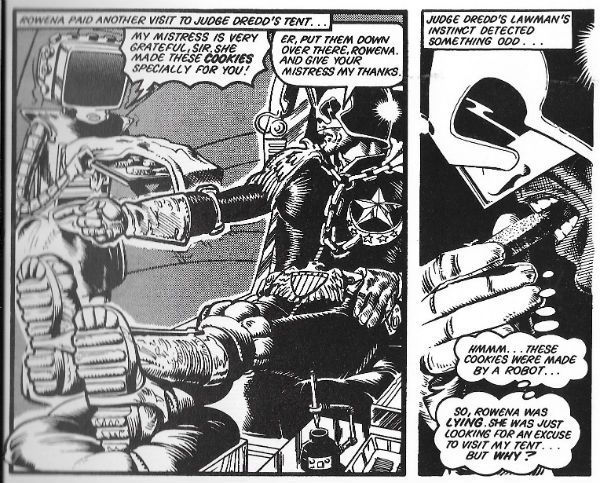 JUDGE DREDD: LAND RACE by Bolland, Wagner and Jacob
JUDGE DREDD: LAND RACE by Bolland, Wagner and Jacob
The Land Race is a riff on the American West tradition of the first person to stake a claim on a piece of land getting to own it. (And by “people” I mean European immigrants; the native Americans were not consulted. I always like it when the Americans descended from European immigrants get all pinch-arsed about immigrants. Dunces.) Bolland has fun designing the vehicles driven by the prospectors, but the mayhem soon gives way to a protracted scene involving an old woman being mind controlled into signing her land away. Amusingly the bad guys are from Interstellar Psionics Corporation, i.e. IPC (the then publishers of 2000AD). There's also a panel of Judge Dredd's head in the corner of which is an X-Wing from the children's entertainment STAR WARS. I think this was to do with a Competition at the time; where you had to find these scattered through the comic to win...er...something to do with STAR WARS. George Lucas' bum fluff? I don't remember that bit; the prize. Unfortunately, we also see here the two Mexican Judges who are, uh, a bit stereotypical what with the sombrero, 'taches and the “Thees” and the “heem”s. Weird in that way only kids '70s could be Walter The Robot gets a girlfriend in the form of Rowena The Robot. Best of all though we discover that Judge Dredd's palate is so disciplined that he can tell the difference between man-made cookies and those made by a robot. Personally I think more should have been made of this and Judge Dredd hereafter is a lesser character without his cookie tasting skills. Trains not taken, eh? All these things are more interesting than the story which is just a lively entertainment, wonderfully drawn by Bolland. But there are worse things to be than entertaining and drawn by Brian Bolland so OKAY!
JUDGE DREDD: THE FIRST LUNA OLYMPICS Art by Brian Bolland Written by John Wagner Lettered by Tony Jacob Originally published in 2000AD Prog 50
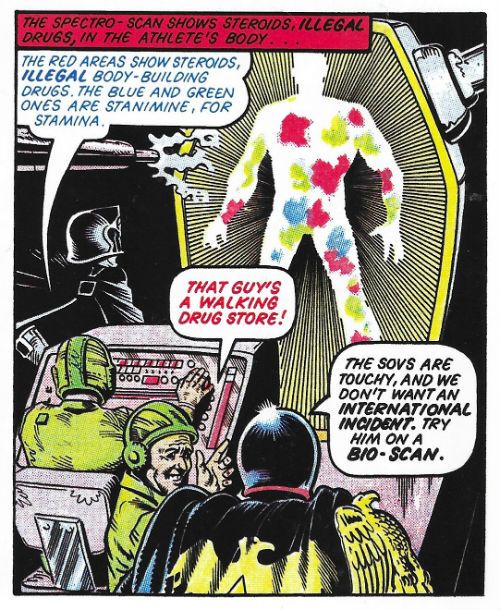 JUDGE DREDD: THE FIRST LUNA OLYMPICS by Bolland, Wagner and Jacob
JUDGE DREDD: THE FIRST LUNA OLYMPICS by Bolland, Wagner and Jacob
Not much to this one beyond Bolland's reliably exemplary art and a horrifically un-Dredd moment. Most of it is a lot of simple jokes about The Olympics. The Sov competitors are full of drugs, and the bits that aren’t full of drugs are mechanical; the high jump is very high because of the low gravity; etc etc. Wagner nails the commentators' voices, and the jokes are mildly amusing jokes, but to his credit it's all a feint because at strip's end Dredd starts a war with the Sovs by accidentally shooting a Sov Judge. It's clearly an accident and the Sovs are over reacting, but Judge Dredd? An accident? Get outta town. I think this is the first appearance of the Sov Judges and Bolland totally nails their appearance; so much so that they have barely changed over the ensuing decades. I particularly like the way their helmets echo those odd toppings on the Kremlin. I thought I might have to do a quick run down of The Cold War and how America and Russia's nuclear cockfencing endangered the whole world. Luckily I don't have to because Putin and Trump have brought it all back. Personally I'd have preferred the return of the Rubik's Cube but there you go, they didn't ask me. Some okay jokes and a super unexpected cliff-hanger, with Bolland's comical realism on top like a tasty Kremlin Onion, is OKAY!
JUDGE DREDD: LUNA-1 WAR Art by Brian Bolland Written by John Wagner Lettered by Tony Jacob Originally published in 2000AD Prog 51
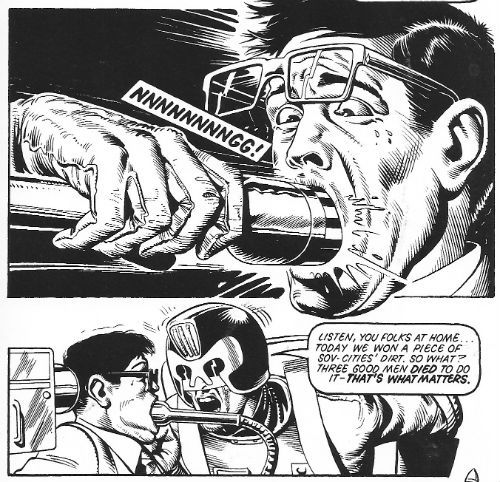 JUDGE DREDD: LUNA-1 WAR by Bolland, Wagner and Jacob
JUDGE DREDD: LUNA-1 WAR by Bolland, Wagner and Jacob
WAR! HUH! Oh, you know that song! In the future Luna 1 War tells us, “Wars today are NO LONGER FOUGHT BETWEEN VAST ARMIES, But by Combat units consisting of FOUR SOLDIERS and one reserve!” This idea doesn't last any longer as the duration of this strip (The Apocalypse War certainly seemed more substantial than a ruck in a pub car park.) but it is a good idea nevertheless. Dredd watches from the side-lines saying awesome things like “We're no better than The Sovs. They use war as an excuse to grab land – we treat it as a GAME!” I'm a-okay with eight year olds reading that despite how it may sound to sophisticated twenty year olds and up. So you can stop rolling your eyes, pal. Anyway, the Sovs are a bad lot so they spike the M-C1 reserve with a “Hypo-Dart”. Big Mistake. Judge Dredd dons a suspiciously Dan Dare-esque helmet and gives those unsporting Sovs' hides a good tanning. For two issues now we've had to “listen” to Wagner's excellently aggravating sports caster (Bolland makes him look like a certain Daily Planet stringer. Heh.) so on our behalf Dredd chokes him with his own mike, turns to the audience and spits, “War is POINTLESS. War is EVIL. WAR IS HELL!”. Hey, sometimes the truth doesn't need nuance. GOOD!
JUDGE DREDD: THE FACE-CHANGE CRIMES Art by Brian Bolland Written by John Wagner Lettered by Tom Frame Originally published in 2000AD Prog 52
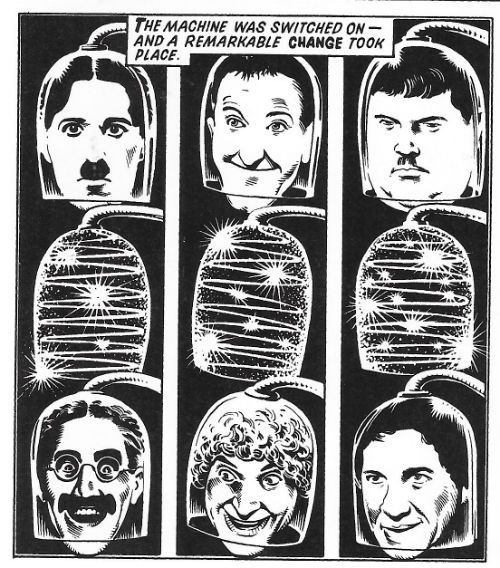 JUDGE DREDD: THE FACE-CHANGE CRIMES by Bolland, Wagner and Frame
JUDGE DREDD: THE FACE-CHANGE CRIMES by Bolland, Wagner and Frame
Unlike the concept of war as a 10 man sporting event, the idea introduced here would persist for the duration of the Dredd strip, causing no end of bedevilment for our future Lawman. It does what it says on the tin, this face-change technology. So here we start with a bank robbery by Laurel and Hardy with Charlie Chaplin, where the robbers evade capture after a bit of !presto-changeo! by being evacuated with the faces of the (3) Marx Brothers. Needless to say Bolland's art is every bit the perfect fit for the bizarre sight of dead 20th century comedians robbing a future bank on the moon. Luckily Judge Dredd has a somewhat unlikely knowledge of deceased 20th Century Comedians and quickly zeroes in on his suspects. Freed by their lawyer, who is a dead ringer for the famous actor and acromegaly sufferer Rondo Hatton, Dredd is left kicking his heels but..."TWO CAN PLAY A DIRTY GAME…!", and he doesn't mean nude Twister. This is a fast and fun one, with Bolland's realism coming to the fore to underscore the visual lunacy of what's going on. You know, VERY GOOD! Personally I feel more could have been made of Dredd's credulity stretching knowledge of 20th Century trivia; it could perhaps have been combined with his amazing ability to tell who cooked what he's eating in order to solve future crimes. On second thoughts we're just a touch of smug irony away from a Matt Fraction Image comic, so forget I said anything. The world doesn't need any more of those.
JUDGE DREDD: THE OXYGEN BOARD Art by Brian Bolland Written by John Wagner Lettered by Tom Frame Originally published in 2000AD Prog 57
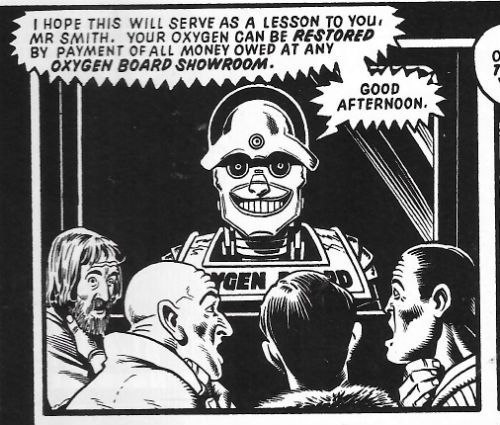 JUDGE DREDD: THE OXYGEN BOARD by Bolland, Wagner and Frame
JUDGE DREDD: THE OXYGEN BOARD by Bolland, Wagner and Frame
This strip is where the young John K(UK) was infused with a life-long detestation of the Free Market philosophy so beloved of soulless cankers who walk like humans. Regulation isn't the enemy, greedy psychopaths are. Sure, I know, I know, if we just leave the provision of services to find its own level no end of good will result. After all, human behaviour is improved no end by the possibility of earning ridiculous amounts of money without obstruction. And if you believe that fairy story/self justificatory pile of horse apples you probably think you can eat the moon on crackers. Anyone who has ever ridden a train in England or received a utility bill know that The Oxygen Board isn't just a possibility; it's inevitable. You also know that Free Market philosophy makes about as much sense as wearing hats made of shit. And if they could charge you for it they'd tell you that was a good idea too. And some of you would do it too. So, uh, yeah, on the moon, oxygen is piped in and billed and if you don't pay your bill...well, that's on you! It's a wicked and powerful punchline most writers would make much hay out of, but Wagner slaps it at the end of a tale of thieves who have robbed the very Oxygen Board itself. Their ironic comeuppance turns the whole thing into a darkly prescient parable. It's drawn by Brian Bolland too, and if that's the only thing that gets people looking at what is a tiny masterpiece then all the better. VERY GOOD!
JUDGE DREDD: FULL EARTH CRIMES Art by Mike McMahon and Brian Bolland Written by John Wagner Lettered by Tom Frame Originally published in 2000AD Prog 58
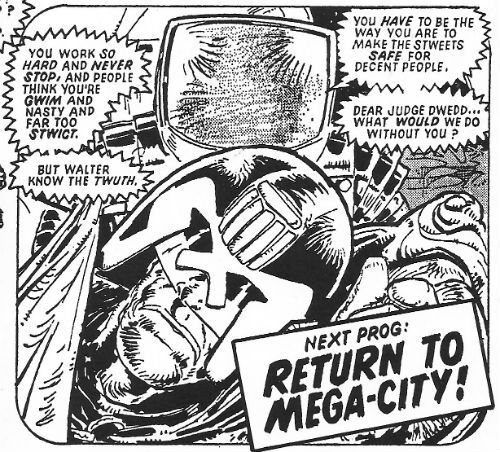 JUDGE DREDD: FULL EARTH CRIMES by McMahon, Wagner and Frame
JUDGE DREDD: FULL EARTH CRIMES by McMahon, Wagner and Frame
This one is better than its simple premise might indicate. On the moon people go loco at Full Earth like people are purported to do on Earth when the moon is full. We then get a conveyor belt of crimes punchily slapped down by the living genius Mike McMahon. It's a succession of funny future crime set-ups each followed by a Dredd-is-a-hard-bastard punchline. E.g Dredd saves a leaper but then gives him 90 days Penal Servitude for public nuisance. Wagner doubles down by having a lady bystander tell Dredd off, because the guy is clearly not the full shilling, only for Dredd to fine her 2,000 Creds for obstructing Justice. Then, with a poker face like iron, Wagner TRIPLES down and when she complains Dredd ups the fine to 4,000 credits. Actually, it is quite funny now I think about it. There’s a bunch of that kind of thing before Dredd goes home exhausted. It's just a string of jokes really, with the double page opening by Bolland and the actual meat of the story by Mike McMahon. Call me unstable but I will always have room in my mind for the final panel where Walter faithfully tucks a blanket around “Dear Judge Dwedd...” OKAY!
JUDGE DREDD: GLOBAL PSYCHO Art by Ian Gibson Written by Gordon Rennie Lettered by Tom Frame Originally published in JUDGE DREDD MEGAZINE #328-331
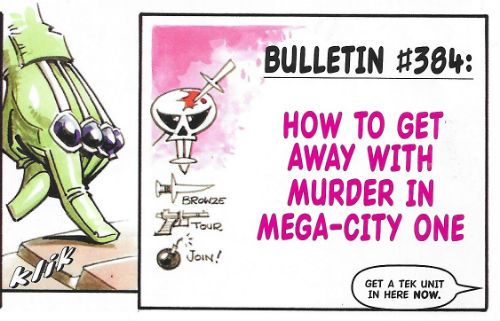 JUDGE DREDD: GLOBAL PSYCHO by Gibson, Rennie and Frame
JUDGE DREDD: GLOBAL PSYCHO by Gibson, Rennie and Frame
Oh, thank Grud. We’re nearly at the end! Oh, you're all feeling the fatigue, what about me? I went to C**********d and back halfway through writing this (round about the Luna-1 War bit) because people think I have to contribute to the social life of the family or something! It was cold and windy enough to require my big coat too! Straight back with “school shoes” and here I have to go on about Gordon Rennie, while fielding black looks from the person cooking the tea. Anyhoo, Judge Dredd is outfoxed by a serial killer in a oner which sets up the somewhat chunkier one which follows on below. Ian Gibson draws in his kind of diseased kid's illustrator style and once again his colours are a delight of polished inkwashes. The most interesting thing for me with Global Psycho is the fact it shows a bum and a bit of tit on a killer's strung up victim. We didn't need a bit of bum and tit in my day! Not in Judge Dredd anyway. What we did our own homes was another matter. It's just a setting up strip so it's OKAY!
JUDGE DREDD: KILLER ELITE Art by Paul Marshall Written by Gordon Rennie Greytones by Jean-Paul Bove Lettered by Tom Frame Originally published in JUDGE DREDD MEGAZINE #328-331
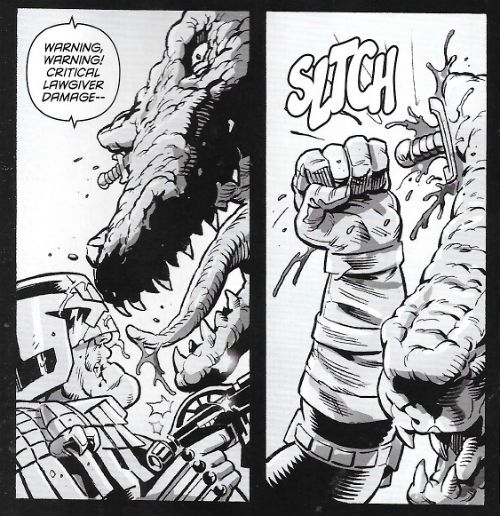 JUDGE DREDD: KILLER ELITE by Marshall, Rennie, Bove and Frame
JUDGE DREDD: KILLER ELITE by Marshall, Rennie, Bove and Frame
Gordon Rennie acquits himself quite well here; it helps he's given himself a strong premise. The psycho from Global Psycho is dying, but before she pops off she collects the galaxy's greatest murderers and has them all face off on the moon. The prize is the seat aboard an escape pod. It doesn't sound like much of a prize, but the complex will explode in sixty minutes and there is only one seat on the escape pod. Dredd's in there because he is after all “the greatest mass murderer in human history”; which by this point in his history is probably understating the matter. It's nice to be reminded how much blood is on Joe's hands every now and again. Particularly if you've recently watched him get tucked up snug by a fawning robot. A whole lot of mayhem ensues but to avoid it all getting a bit one-note Rennie builds the trap around Dredd so tightly that by the time he reaches the pod with another survivor you really don't know how he's going to get out of it. It's fast and fun, and if not quite as fast or fun as Rennie might think, it's fast and fun enough. The only let down is the art. While there's nothing wrong with Marshall's typically sturdy work, someone has made the (cost cutting?) decision to go for gray tones instead of colour. This makes it all a bit visually drab, so much so it starts to undermine the art. The swathes of gray don't allow anything to pop, even when you know what you are looking at should be popping like Space Dust on a pre-teen's tongue. But Dredd's convincingly Dredd, and Rennies' Most Dangerous Game is dangerous enough so GOOD!
DARK SIDE OF THE MOON shows that Luna-1 is whatever any particular writer requires of it; empty and forbidding in Breathing Space, noisy and garish in Darkside, bustling and crazed in the original strips and the moon is just, well, there as a deadly backdrop in Killer Elite. It doesn't really matter as the freedom allows all these different approaches; and while some work (Breathing Space) and some don't (Darkside) none of that's down to the setting. As a volume it's GOOD!
NEXT TIME: Manners maketh the Judge, so says Judge Mum and - COMICS!!!


